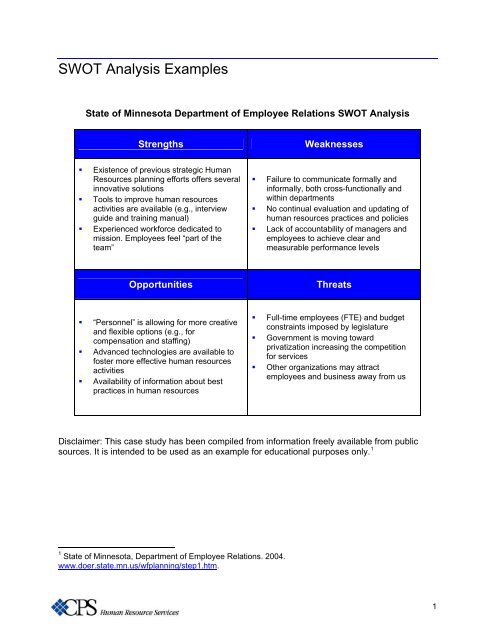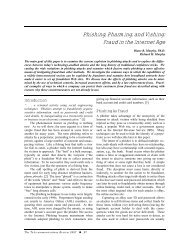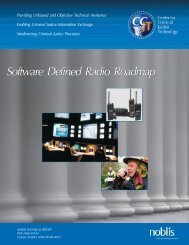SWOT Analysis Examples - CPS Human Resource Services
SWOT Analysis Examples - CPS Human Resource Services
SWOT Analysis Examples - CPS Human Resource Services
Create successful ePaper yourself
Turn your PDF publications into a flip-book with our unique Google optimized e-Paper software.
<strong>SWOT</strong> <strong>Analysis</strong> <strong>Examples</strong>State of Minnesota Department of Employee Relations <strong>SWOT</strong> <strong>Analysis</strong>StrengthsWeaknesses• Existence of previous strategic <strong>Human</strong><strong>Resource</strong>s planning efforts offers severalinnovative solutions• Tools to improve human resourcesactivities are available (e.g., interviewguide and training manual)• Experienced workforce dedicated tomission. Employees feel “part of theteam”• Failure to communicate formally andinformally, both cross-functionally andwithin departments• No continual evaluation and updating ofhuman resources practices and policies• Lack of accountability of managers andemployees to achieve clear andmeasurable performance levelsOpportunitiesThreats• “Personnel” is allowing for more creativeand flexible options (e.g., forcompensation and staffing)• Advanced technologies are available tofoster more effective human resourcesactivities• Availability of information about bestpractices in human resources• Full-time employees (FTE) and budgetconstraints imposed by legislature• Government is moving towardprivatization increasing the competitionfor services• Other organizations may attractemployees and business away from usDisclaimer: This case study has been compiled from information freely available from publicsources. It is intended to be used as an example for educational purposes only. 11 State of Minnesota, Department of Employee Relations. 2004.www.doer.state.mn.us/wfplanning/step1.htm.1
Workforce Planning Tool Kit<strong>SWOT</strong> <strong>Analysis</strong> <strong>Examples</strong>Department of Social <strong>Services</strong> <strong>SWOT</strong> ANALYSISStrengthsWeaknesses• Experienced, resourceful, dedicatedworkforce• Strong communitypartnerships/collaboration• Continuous Quality Improvement promotesteamwork• Proactive management team• Parking for customers• Diminished <strong>Resource</strong>s – IncreasedConsumer Demand• Uniformity across divisionsOpportunitiesThreats• Leadership training for possibleadvancement• Collaborate with community partners• Promote teamwork across divisions• Identify/tap into staff hidden strengths• Staff turnover• Budget• Privatization• Fewer people willing to do child welfareDisclaimer: This case study has been compiled from information available from public sources.This <strong>SWOT</strong> is based on an analysis completed as part of the strategic planning process forWashington County (Maryland) social services. 2 It is intended to be used as an example foreducational purposes only.2www.dhr.state.md.us/county/washing/plan06.pdf, Strategic Plan (Revised September 28, 2005 forFY’06) For the period: July 2003-June 30, 2007, <strong>SWOT</strong> ANALYSIS (Updated September 28, 2005).2
Workforce Planning Tool Kit<strong>SWOT</strong> <strong>Analysis</strong> <strong>Examples</strong>Social Work Education in Canada <strong>SWOT</strong> <strong>Analysis</strong>Strengths• A holistic practice orientation• The linkage between theory and practice• Regulation and certification• A generalist approach to practice• Increased cultural relevance of social workeducation• High quality social work programs• A continued demand for social worker• The values of the professionWeaknesses• Lack of professional identification, oridentity crisis• An inability to promote the profession• The diffuse knowledge base of theprofession• Conflict between the values of socialaction and social control• A lack of preparation to manage thestress of our work• Insufficient aboriginal, visible minorityand multicultural members of theprofessionOpportunitiesThreats• A trend to neoliberalism• Increasing identification of social workerswith the bureaucracy• Increasing managerialization• Increased community responsibility forservice delivery• Interdisciplinarity• Design of cost effective programs whichmeet service user needs• Exercise of responsibility for socialadvocacy• Development of managerialcompetence in social workers• Extension of job opportunities throughprivatization• Articulation of social workcompetenciesDisclaimer: This case study has been compiled from information available from public sources.This <strong>SWOT</strong> is based on research carried out for a study of human resource needs of socialworkers in Canada. 3 It is intended to be used as an example for educational purposes only.3Westhues, Anne, Jean Lafrance and Glen Schmidt. Taylor & Francis Group Online Journals. Volume 20,Number 1. February 1, 2001http://taylorandfrancis.metapress.com/(i3hlye3tvul0xl45kotytg55)/app/home/contribution.asp?referrer=parent&backto=issue,4,13;journal,41,103;linkingpublicationresults,1:104324,13
Workforce Planning Tool Kit<strong>SWOT</strong> <strong>Analysis</strong> <strong>Examples</strong>Alaska Children Experiencing Homelessness <strong>SWOT</strong> <strong>Analysis</strong>StrengthsWeaknesses• Alaska is very wealthy. Large amount ofnatural resources, but we have limitedaccess to them. $30 billion in permanentfund, $2 billion state reserve. Can accessinterest from fund, but not the principal• Mental health trust authority, AK housingAuthority is in better shape than otherplaces. Native corporations can contributeto their regions (some)• Some tribal governments apply for grants,e.g., to refurbish housing in rural areas• Less local government – less taxrevenue. This is often by local choice• Funding allows agencies to stand aloneand not require collaboration toaccomplish their work• Money is not always tied to outcomes• Multiple funding streams also can leadto lack of coordination• Lack of roads and infrastructure. Costsmore to buildOpportunitiesThreats• Set up trust funds, because State haswealth• Lot of planning going on and need tointegrate all the plans• Involving business or corporate communityto address this issue, e.g., housing of theirown workforce• Can go to each community for resourcesthat they can bring to the table• Medicaid match change• Cost of and lack of access health careis a threat• Weakening federal support to states.Contracting block grant funding• Housing costs rise and out-pace wages• Federal funding doesn’t cover operatingfunds. Funding for specific little projectsDisclaimer: This case study has been compiled from information available from public sources. 4It is intended to be used as an example for educational purposes only.4 www.hrsa.gov/homeless/pa_materials/pa8/0502.rtf, Improving Access to Mainstream <strong>Services</strong> forFamilies with Children experiencing Homelessness. Intercontinental Hotel, Houston, Texas, April 20-22,2005.4
Workforce Planning Tool Kit<strong>SWOT</strong> <strong>Analysis</strong> <strong>Examples</strong>Starbucks <strong>SWOT</strong> <strong>Analysis</strong>StrengthsWeaknesses• Starbucks Corporation is a very profitableorganization, earning in excess of $600 millionin 2004.• It is a global coffee brand built upon areputation for fine products and services.• Starbucks was one of the Fortune Top 100Companies to Work For in 2005. The companyis a respected employer that values itsworkforce.• The organization has strong ethical values andan ethical mission statement.• Starbucks has a reputation for new productdevelopment and creativity. However, theyremain vulnerable to the possibility that theirinnovation may falter over time.• The organization has a strong presence inthe United States of America. It is oftenargued that they need to look for a portfolio ofcountries, in order to spread business risk.• The organization is dependant on a maincompetitive advantage, the retail of coffee.This could make them slow to diversify intoother sectors should the need arise.OpportunitiesThreats• Starbucks are very good at taking advantage ofopportunties.• In 2004 the company created a CD-burningservice in their Santa Monica (California USA)cafe with Hewlett Packard, where customerscreate their own music CD.• New products and services that can be retailedin their cafes, such as Fair Trade products.• The company has the opportunity to expand itsglobal operations. New markets for coffee suchas India and the Pacific Rim nations arebeginning to emerge.• Co-branding with other manufacturers of foodand drink, and brand franchising tomanufacturers of other goods and services bothhave potential.• Who knows if the market for coffee will growand stay in favour with customers, or whetheranother type of beverage or leisure activitywill replace coffee in the future?• Starbucks are exposed to rises in the cost ofcoffee and dairy products.• Since its conception in Pike Place Market,Seattle in 1971, Starbucks' success has leadto the market entry of many competitors andcopy cat brands that pose potential threats.Disclaimer: This case study has been compiled from information freely available from publicsources. It is intended to be used as an example for educational purposes only. 55 www.marketingteacher.com/<strong>SWOT</strong>/starbucks_swot.htm5
Workforce Planning Tool Kit<strong>SWOT</strong> <strong>Analysis</strong> <strong>Examples</strong>Nike <strong>SWOT</strong> <strong>Analysis</strong>StrengthsWeaknesses• Nike is a very competitive organization.• Nike has no factories. It does not tie up cash inbuildings and manufacturing workers. Thismakes a very lean organization.• Nike is strong at research and development.• Nike is a global brand.• The organization does have a diversifiedrange of sports products. However, theincome of the business is still heavilydependent upon its share of the footwearmarket. This may leave it vulnerable if forany reason its market share erodes.• The retail sector is very price sensitive.Nike does have its own retailer in NikeTown. However, most of its income isderived from selling into retailers.OpportunitiesThreats• Product development offers Nike manyopportunities. The brand is fiercely defended byits owners whom truly believe that Nike is not afashion brand. However, like it or not,consumers that wear Nike product do notalways buy it to participate in sport. This createsits own opportunities, since product couldbecome unfashionable before it wears out i.e.consumers need to replace shoes.• There is also the opportunity to developproducts such as sport wear, sunglasses andjewellery. Such high value items do tend to haveassociated with them, high profits.• The business could also be developedinternationally, building upon its strong globalbrand recognition. There are many markets thathave the disposable income to spend on highvalue sports goods. For example, emergingmarkets such as China and India have a newricher generation of consumers.• Nike is exposed to the internationalnature of trade. It buys and sells indifferent currencies and so costs andmargins are not stable over long periodsof time. Such an exposure could meanthat Nike may be manufacturing and/orselling at a loss. This is an issue thatfaces all global brands.• The market for sports shoes andgarments is very competitive.• As discussed above in weaknesses, theretail sector is becoming pricecompetitive. This ultimately means thatconsumers are shopping around for abetter deal.Disclaimer: This case study has been compiled from information freely available from publicsources. It is intended to be used as an example for educational purposes only. 66 www.marketingteacher.com/<strong>SWOT</strong>/nike_swot.htm6







